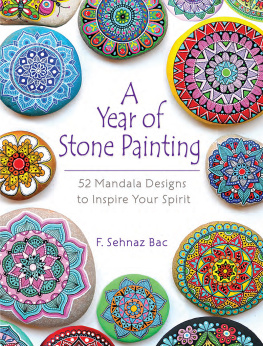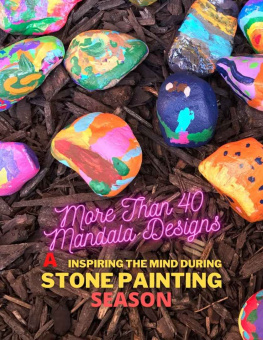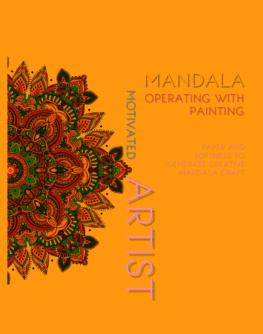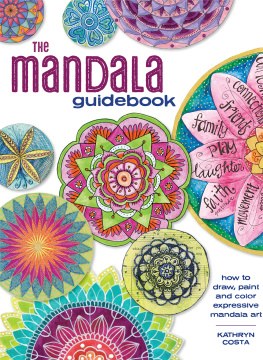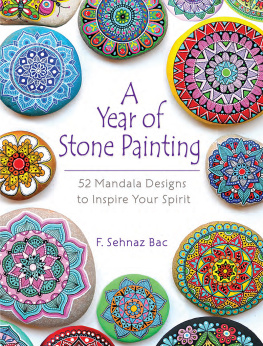

Copyright
Copyright 2019 by F. Sehnaz Bac
All rights reserved.
Bibliographical Note
A Year of Stone Painting: 52 Mandala Designs to Inspire Your Spirit
is a new work, first published by Dover Publications, Inc., in 2019.
International Standard Book Number
ISBN-13: 978-0-486-82852-7
ISBN-10: 0-486-82852-2
Manufactured in the United States by LSC Communications
82852201 2019
www.doverpublications.com
This book is dedicated to my daughters,
Ayse and Zeynep Meric,
and my husband, Artabano Forcellese,
for their patience and support.
Omnia vincit amor.


Contents
A
Year of
Stone Painting


Introduction
A Year of Stone Painting is not simply about painting mandalas on stones; it is also about meditation. You will find in this book fifty-two projects with inspirational words, one for every week of the year, and experience a relaxing process while carrying out all the steps. The purpose of this book goes beyond suggesting designs and teaching techniques. I want you to make this artistic experience a means to establish a state of meditation and relaxation and to commune with the energy of peacefulness and regeneration. This positive energy will no doubt spark from the very act of painting the mandalas and looking for the stones in the natural places where they have been formed and shaped.
As you complete one project every week, you will start to feel that there is an intimate rapport between you, the stones, and each design to which you are dedicating yourself with love, attention, concentration, devotedness, and commitment.
With each inspirational word acting as your mantra, it will be a truly meditative practice. You will find yourself in communion with nature; with the time it takes to shape the stone; with the amount of water that has flowed over it; with the act of picking it up, feeling its texture, admiring its shape.
I hope my designs will inspire you to begin this artistic and meditative journey, sparking your creativity and producing a relaxing mood while leading you to find your way to create your own mandala stones.
MANDALA
Mandala comes from the ancient Sanskrit language and means circle or completion, referring to the sense of wholeness created by the circular form. The circle itself is a dynamic figure. That is why it is described by mathematicians as a polygon having an infinite number of sides. The circle is the most natural form known to humankind: the sun and moon, planets and stars, water drops, tree trunks, flowers. It also is the first shape a child learns to draw.
A mandala represents the universe, and it is used as a spiritual guidance tool that helps in the induction of meditation and trance. It reflects eternity and the center of all creation. In Buddhist tradition, the act of creating a mandala represents transformation of the universe from a reality of suffering to one of enlightenment. The center of a mandala represents the beginning of a journey toward knowledge and wisdom, and that is why it is often used to help focus the mind during meditation. We can see many mandala forms in nature: shells, flowers, the core of fruits and vegetables, snowflakes, spiderwebs, and so on.
If we look closely at a flower, and likewise at other natural and manmade creations, we find a unity and an order common to all of them. This order can be seen in certain proportions, which appear again and again, and also in the similarly dynamic way all things grow or are made by a union of complementary opposites. (Gyrgy Dczi, The Power of Limits: Proportional Harmonies in Nature, Art, and Architecture)
A mandala design starts to evolve from nothing. It begins with a point, and from there it develops with different shapes, forms, and figures, mostly in a series of circular forms (rows). Mandalas can be designed inside of squares or rectangles, but their main form is round. The designs in this book are circular in form. Some are drawn freehand, and others are created with the help of basic geometric rules and formulas.

Getting Started
FINDING STONES
The first step to create mandalas is to find suitable stones. Make sure you have checked local laws about taking them from their natural surroundings, and always respect the environment by using different locations rather than always tapping the same place. The seaside is the most common place to find stones, but lakes and rivers offer a wide variety of sizes and shapes too.
You also can purchase stones from a rock supplier. Search online and in your local area for landscape supplies, craft stores, and garden centers.

HOW TO SELECT STONES
Sizes and Shapes
Sizes should range from one inch to six inches, and round and oval shapes work best. Bigger stones will give you a large area to paint and to easily add details. An unusual-shaped stone may prove to be an original base that may inspire you to produce a mandala design.
Colors
Stones can be any color. However, if you prefer to draw your design on the raw base, leaving the original texture, generally the lighter the shade, the better. Different colors can prove to be quite rewarding when you realize the special effects you can achieve with unusual shades as a base, coupled with your design.

Textures
The smoother the surface, the better result you will obtain. Avoid any stone that has imperfections you cannot eliminate and that may interfere with your end result. If you find beautifully round stones with rough and porous surfaces, pick them. You will have the chance to use them, with a little corrective work.
PREPARING STONES
Before starting to paint your stones, clean them thoroughly. Leave them in water for a few hours and then, with a soft brush and mild soap, wash them under running water. Let them dry naturally.
If you have stones that have rough and porous surfaces, sand them with extra fine grit sandpaper and remove any residual dust with a damp cloth or a brush. Apply two coats of white acrylic paint to create a smoother layer. Press the brush in order to allow the stones pores to take in the paint. Once the stones are completely dry, gently sand them and clean them again.

